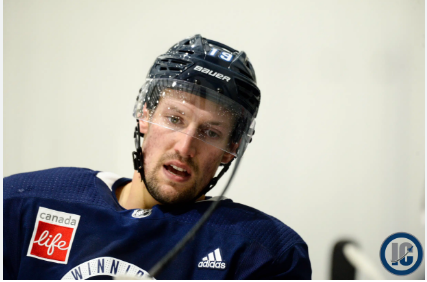
In a troubling update from the Winnipeg Jets, a 24-year-old forward has been diagnosed with a concussion following a significant in-game incident. The injury, which occurred during last night’s matchup, has raised concerns for both the player’s health and the team’s immediate prospects.
The Incident
The injury took place during the second period of the game against the [opposing team], when the Jets forward was involved in a heavy collision near the boards. As per initial reports, the player was hit by an opposing defenseman while attempting to make a pass, resulting in a violent impact to the head. The forward immediately appeared shaken, clutching his head as he was helped off the ice by the team’s medical staff.
Immediate Response
The Jets’ medical team quickly assessed the situation, and the player was seen leaving the ice under his own power, although visibly unsteady. Following further evaluation in the locker room, the decision was made to hold him out for the remainder of the game. In a statement released after the game, the Jets confirmed that the forward had suffered a concussion and would undergo additional testing to determine the full extent of the injury.
Head coach Rick Bowness addressed the media post-game, expressing concern for the well-being of his player. “It’s always tough to see one of your guys go down, especially with a head injury,” Bowness said. “Our priority is to ensure that he gets the proper care and is given the time he needs to recover fully.”
What Comes Next?
The Jets have not yet provided a detailed timeline for the player’s return, noting that recovery from concussions is unpredictable and can vary significantly from case to case. The forward will be monitored closely in the coming days, with a protocol in place for gradual return to activity. The team will likely keep him out of the lineup for an extended period, depending on his recovery process.
This incident marks the latest in a growing concern around head injuries in hockey, where players continue to be at risk for concussions due to the physical nature of the sport. While the NHL has taken steps to address player safety, including fines, suspensions, and changes to game rules to reduce dangerous hits, incidents like this continue to highlight the unpredictable risks players face.
### Impact on the Winnipeg Jets
The injury is a significant blow for the Jets, who have been relying on the young forward as a key contributor to their offense this season. His absence from the lineup will undoubtedly affect the team’s chemistry and scoring depth, particularly in the context of a highly competitive division race.
In the interim, the Jets will likely turn to their depth players to fill the void left by the injured forward. With a busy schedule ahead, they’ll need to make strategic adjustments to keep pace with their rivals in the Western Conference.
A Call for Player Safety
While the focus remains on the player’s recovery, the incident also raises important questions about the safety of players in the NHL. The league has faced increasing scrutiny over head injuries, with players and medical professionals calling for more stringent measures to prevent concussions and better protect athletes from long-term brain injuries.
Concussions have become a major talking point in professional sports, with growing concern over the cumulative effects of multiple head injuries over a player’s career. Many players, after facing concussions, struggle with lingering effects such as memory loss, headaches, and even depression, leading to calls for enhanced protocols, better education on the risks, and improved technologies to better detect concussions during gameplay.
Conclusion
As the Winnipeg Jets await further updates on their 24-year-old forward’s condition, the hockey world is reminded of the inherent risks players face when they step onto the ice. Fans, teammates, and the entire hockey community are hoping for a full and speedy recovery for the young forward, while continuing the broader conversation on how the sport can evolve to better protect its athletes.

Leave a Reply